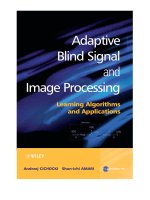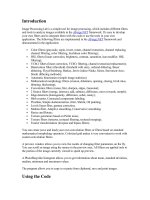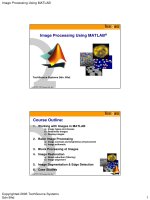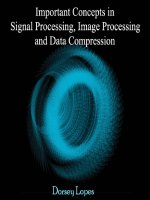Linear Image Processing
Bạn đang xem bản rút gọn của tài liệu. Xem và tải ngay bản đầy đủ của tài liệu tại đây (2.02 MB, 26 trang )
397
CHAPTER
24
Linear Image Processing
Linear image processing is based on the same two techniques as conventional DSP: convolution
and Fourier analysis. Convolution is the more important of these two, since images have their
information encoded in the spatial domain rather than the frequency domain. Linear filtering can
improve images in many ways: sharpening the edges of objects, reducing random noise, correcting
for unequal illumination, deconvolution to correct for blur and motion, etc. These procedures are
carried out by convolving the original image with an appropriate filter kernel, producing the
filtered image. A serious problem with image convolution is the enormous number of calculations
that need to be performed, often resulting in unacceptably long execution times. This chapter
presents strategies for designing filter kernels for various image processing tasks. Two important
techniques for reducing the execution time are also described: convolution by separability and
FFT convolution.
Convolution
Image convolution works in the same way as one-dimensional convolution. For
instance, images can be viewed as a summation of impulses, i.e., scaled and
shifted delta functions. Likewise, linear systems are characterized by how they
respond to impulses; that is, by their impulse responses. As you should expect,
the output image from a system is equal to the input image convolved with the
system's impulse response.
The two-dimensional delta function is an image composed of all zeros, except
for a single pixel at: row = 0, column = 0, which has a value of one. For now,
assume that the row and column indexes can have both positive and negative
values, such that the one is centered in a vast sea of zeros. When the delta
function is passed through a linear system, the single nonzero point will be
changed into some other two-dimensional pattern. Since the only thing that can
happen to a point is that it spreads out, the impulse response is often called the
point spread function (PSF) in image processing jargon.
The Scientist and Engineer's Guide to Digital Signal Processing398
a. Image at first layer
b. Image at third layer
FIGURE 24-1
The PSF of the eye. The middle layer of the retina changes an impulse, shown in (a), into an impulse
surrounded by a dark area, shown in (b). This point spread function enhances the edges of objects.
The human eye provides an excellent example of these concepts. As described
in the last chapter, the first layer of the retina transforms an image represented
as a pattern of light into an image represented as a pattern of nerve impulses.
The second layer of the retina processes this neural image and passes it to the
third layer, the fibers forming the optic nerve. Imagine that the image being
projected onto the retina is a very small spot of light in the center of a dark
background. That is, an impulse is fed into the eye. Assuming that the system
is linear, the image processing taking place in the retina can be determined by
inspecting the image appearing at the optic nerve. In other words, we want to
find the point spread function of the processing. We will revisit the
assumption about linearity of the eye later in this chapter.
Figure 24-1 outlines this experiment. Figure (a) illustrates the impulse striking
the retina while (b) shows the image appearing at the optic nerve. The middle
layer of the eye passes the bright spike, but produces a circular region of
increased darkness. The eye accomplishes this by a process known as lateral
inhibition. If a nerve cell in the middle layer is activated, it decreases the
ability of its nearby neighbors to become active. When a complete image is
viewed by the eye, each point in the image contributes a scaled and shifted
version of this impulse response to the image appearing at the optic nerve. In
other words, the visual image is convolved with this PSF to produce the neural
image transmitted to the brain. The obvious question is: how does convolving
a viewed image with this PSF improve the ability of the eye to understand the
world?
Chapter 24- Linear Image Processing 399
a. True brightness
b. Perceived brightness
FIGURE 24-2
Mach bands. Image processing in the
retina results in a slowly changing edge,
as in (a), being sharpened, as in (b). This
makes it easier to separate objects in the
image, but produces an optical illusion
called Mach bands. Near the edge, the
overshoot makes the dark region look
darker, and the light region look lighter.
This produces dark and light bands that
run parallel to the edge.
Humans and other animals use vision to identify nearby objects, such as
enemies, food, and mates. This is done by distinguishing one region in the
image from another, based on differences in brightness and color. In other
words, the first step in recognizing an object is to identify its edges, the
discontinuity that separates an object from its background. The middle layer
of the retina helps this task by sharpening the edges in the viewed image. As
an illustration of how this works, Fig. 24-2 shows an image that slowly
changes from dark to light, producing a blurry and poorly defined edge. Figure
(a) shows the intensity profile of this image, the pattern of brightness entering
the eye. Figure (b) shows the brightness profile appearing on the optic nerve,
the image transmitted to the brain. The processing in the retina makes the edge
between the light and dark areas appear more abrupt, reinforcing that the two
regions are different.
The overshoot in the edge response creates an interesting optical illusion. Next
to the edge, the dark region appears to be unusually dark, and the light region
appears to be unusually light. The resulting light and dark strips are called
Mach bands, after Ernst Mach (1838-1916), an Austrian physicist who first
described them.
As with one-dimensional signals, image convolution can be viewed in two
ways: from the input, and from the output. From the input side, each pixel in
The Scientist and Engineer's Guide to Digital Signal Processing400
the input image contributes a scaled and shifted version of the point spread
function to the output image. As viewed from the output side, each pixel in
the output image is influenced by a group of pixels from the input signal. For
one-dimensional signals, this region of influence is the impulse response flipped
left-for-right. For image signals, it is the PSF flipped left-for-right and top-
for-bottom. Since most of the PSFs used in DSP are symmetrical around the
vertical and horizonal axes, these flips do nothing and can be ignored. Later
in this chapter we will look at nonsymmetrical PSFs that must have the flips
taken into account.
Figure 24-3 shows several common PSFs. In (a), the pillbox has a circular top
and straight sides. For example, if the lens of a camera is not properly focused,
each point in the image will be projected to a circular spot on the image sensor
(look back at Fig. 23-2 and consider the effect of moving the projection screen
toward or away from the lens). In other words, the pillbox is the point spread
function of an out-of-focus lens.
The Gaussian, shown in (b), is the PSF of imaging systems limited by random
imperfections. For instance, the image from a telescope is blurred by
atmospheric turbulence, causing each point of light to become a Gaussian in the
final image. Image sensors, such as the CCD and retina, are often limited by
the scattering of light and/or electrons. The Central Limit Theorem dictates
that a Gaussian blur results from these types of random processes.
The pillbox and Gaussian are used in image processing the same as the moving
average filter is used with one-dimensional signals. An image convolved with
these PSFs will appear blurry and have less defined edges, but will be lower
in random noise. These are called smoothing filters, for their action in the
time domain, or low-pass filters, for how they treat the frequency domain.
The square PSF, shown in (c), can also be used as a smoothing filter, but it
is not circularly symmetric. This results in the blurring being different in the
diagonal directions compared to the vertical and horizontal. This may or may
not be important, depending on the use.
The opposite of a smoothing filter is an edge enhancement or high-pass
filter. The spectral inversion technique, discussed in Chapter 14, is used to
change between the two. As illustrated in (d), an edge enhancement filter
kernel is formed by taking the negative of a smoothing filter, and adding a
delta function in the center. The image processing which occurs in the retina
is an example of this type of filter.
Figure (e) shows the two-dimensional sinc function. One-dimensional signal
processing uses the windowed-sinc to separate frequency bands. Since images
do not have their information encoded in the frequency domain, the sinc
function is seldom used as an imaging filter kernel, although it does find use
in some theoretical problems. The sinc function can be hard to use because its
tails decrease very slowly in amplitude ( ), meaning it must be treated as1/x
infinitely wide. In comparison, the Gaussian's tails decrease very rapidly
( ) and can eventually be truncated with no ill effect.e
&x
2
Chapter 24- Linear Image Processing 401
c. Square
-8
-6
-4
-2
0
2
4
6
8
-2
-4
-6
-8
4
3
2
1
0
8
6
4
2
0
colrow
a. Pillbox
-8
-6
-4
-2
0
2
4
6
8
-2
-4
-6
-8
4
3
2
1
0
8
6
4
2
0
colrow
b. Gaussian
-8
-6
-4
-2
0
2
4
6
8
-2
-4
-6
-8
4
3
2
1
0
8
6
4
2
0
colrow
d. Edge enhancement
-8
-6
-4
-2
0
2
4
6
8
-2
-4
-6
-8
4
3
2
1
0
8
6
4
2
0
colrow
e. Sinc
-8
-6
-4
-2
0
2
4
6
8
-2
-4
-6
-8
4
3
2
1
0
8
6
4
2
0
colrow
FIGURE 24-3
Common point spread functions. The pillbox,
Gaussian, and square, shown in (a), (b), & (c),
are common smoothing (low-pass) filters. Edge
enhancement (high-pass) filters are formed by
subtracting a low-pass kernel from an impulse,
as shown in (d). The sinc function, (e), is used
very little in image processing because images
have their information encoded in the spatial
domain, not the frequency domain.
valuevalue
valuevalue value
All these filter kernels use negative indexes in the rows and columns, allowing
the PSF to be centered at row = 0 and column = 0. Negative indexes are often
eliminated in one-dimensional DSP by shifting the filter kernel to the right until
all the nonzero samples have a positive index. This shift moves the output
signal by an equal amount, which is usually of no concern. In comparison, a
shift between the input and output images is generally not acceptable.
Correspondingly, negative indexes are the norm for filter kernels in image
processing.
The Scientist and Engineer's Guide to Digital Signal Processing402
A problem with image convolution is that a large number of calculations are
involved. For instance, when a 512 by 512 pixel image is convolved with a 64
by 64 pixel PSF, more than a billion multiplications and additions are needed
(i.e., ). The long execution times can make the techniques64×64×512×512
impractical. Three approaches are used to speed things up.
The first strategy is to use a very small PSF, often only 3×3 pixels. This is
carried out by looping through each sample in the output image, using
optimized code to multiply and accumulate the corresponding nine pixels from
the input image. A surprising amount of processing can be achieved with a
mere 3×3 PSF, because it is large enough to affect the edges in an image.
The second strategy is used when a large PSF is needed, but its shape isn't
critical. This calls for a filter kernel that is separable, a property that allows
the image convolution to be carried out as a series of one-dimensional
operations. This can improve the execution speed by hundreds of times.
The third strategy is FFT convolution, used when the filter kernel is large and
has a specific shape. Even with the speed improvements provided by the
highly efficient FFT, the execution time will be hideous. Let's take a closer
look at the details of these three strategies, and examples of how they are used
in image processing.
3×3 Edge Modification
Figure 24-4 shows several 3×3 operations. Figure (a) is an image acquired by
an airport x-ray baggage scanner. When this image is convolved with a 3×3
delta function (a one surrounded by 8 zeros), the image remains unchanged.
While this is not interesting by itself, it forms the baseline for the other filter
kernels.
Figure (b) shows the image convolved with a 3×3 kernel consisting of a one,
a negative one, and 7 zeros. This is called the shift and subtract operation,
because a shifted version of the image (corresponding to the -1) is subtracted
from the original image (corresponding to the 1). This processing produces the
optical illusion that some objects are closer or farther away than the
background, making a 3D or embossed effect. The brain interprets images as
if the lighting is from above, the normal way the world presents itself. If the
edges of an object are bright on the top and dark on the bottom, the object is
perceived to be poking out from the background. To see another interesting
effect, turn the picture upside down, and the objects will be pushed into the
background.
Figure (c) shows an edge detection PSF, and the resulting image. Every
edge in the original image is transformed into narrow dark and light bands
that run parallel to the original edge. Thresholding this image can isolate
either the dark or light band, providing a simple algorithm for detecting the
edges in an image.
Chapter 24- Linear Image Processing 403
FIGURE 24-4
3×3 edge modification. The original image, (a), was acquired on an airport x-ray baggage scanner. The shift and subtract
operation, shown in (b), results in a pseudo three-dimensional effect. The edge detection operator in (c) removes all
contrast, leaving only the edge information. The edge enhancement filter, (d), adds various ratios of images (a) and (c),
determined by the parameter, k. A value of k = 2 was used to create this image.
-k/8-k/8
-k/8
-k/8 -k/8 -k/8
-k/8
k+1
00
0
0 0 0
0
0
1
-1/8-1/8
-1/8
-1/8 -1/8 -1/8
-1/8
-1/8
1
00
0
0 0
-1
0
0
1
-k/8
a. Delta function b. Shift and subtract
c. Edge detection d. Edge enhancement
A common image processing technique is shown in (d): edge enhancement.
This is sometimes called a sharpening operation. In (a), the objects have good
contrast (an appropriate level of darkness and lightness) but very blurry edges.
In (c), the objects have absolutely no contrast, but very sharp edges. The
The Scientist and Engineer's Guide to Digital Signal Processing404
EQUATION 24-1
Image separation. An image is referred to
as separable if it can be decomposed into
horizontal and vertical projections.
x[r,c] ' vert [r] × horz [c]
strategy is to multiply the image with good edges by a constant, k, and add it
to the image with good contrast. This is equivalent to convolving the original
image with the 3×3 PSF shown in (d). If k is set to 0, the PSF becomes a delta
function, and the image is left unchanged. As k is made larger, the image
shows better edge definition. For the image in (d), a value of k = 2 was used:
two parts of image (c) to one part of image (a). This operation mimics the
eye's ability to sharpen edges, allowing objects to be more easily separated
from the background.
Convolution with any of these PSFs can result in negative pixel values
appearing in the final image. Even if the program can handle negative values
for pixels, the image display cannot. The most common way around this is to
add an offset to each of the calculated pixels, as is done in these images. An
alternative is to truncate out-of-range values.
Convolution by Separability
This is a technique for fast convolution, as long as the PSF is separable. A
PSF is said to be separable if it can be broken into two one-dimensional
signals: a vertical and a horizontal projection. Figure 24-5 shows an example
of a separable image, the square PSF. Specifically, the value of each pixel in
the image is equal to the corresponding point in the horizontal projection
multiplied by the corresponding point in the vertical projection. In
mathematical form:
where is the two-dimensional image, and & are the one-x[r,c] vert[r] horz[c]
dimensional projections. Obviously, most images do not satisfy this
requirement. For example, the pillbox is not separable. There are, however,
an infinite number of separable images. This can be understood by generating
arbitrary horizontal and vertical projections, and finding the image that
corresponds to them. For example, Fig. 24-6 illustrates this with profiles that
are double-sided exponentials. The image that corresponds to these profiles is
then found from Eq. 24-1. When displayed, the image appears as a diamond
shape that exponentially decays to zero as the distance from the origin
increases.
In most image processing tasks, the ideal PSF is circularly symmetric, such
as the pillbox. Even though digitized images are usually stored and
processed in the rectangular format of rows and columns, it is desired to
modify the image the same in all directions. This raises the question: is
there a PSF that is circularly symmetric and separable? The answer is, yes,
Chapter 24- Linear Image Processing 405
0
0
0 0 0 0 0 0
0 0
0 0 0 0 0 0 0
0 0 0 0 0 0 0 0 0 0 0
0 0 0 0 0 0 0 0 0 0 0 0 0
0 0 0
0 0 0
0 0 0
0 0 0
0 0 0
0 0 0
0 0 0
0 0 0
0 0 0
0 0 0
0 0 0
0 0
0 0 0 0 0
0
0
0 0 0 0 0 0 0 0 0 0 0 0 0
0 0 0 0 0 0 0 0 0 0 0 0 0
0 0 0 0 0 0 0 0 0 0 0 0 0
1 1 1 1 1 1 1
1 1 1 1 1 1 1
1 1 1 1 1 1 1
1 1 1 1 1 1 1
1 1 1 1 1 1 1
1 1 1 1 1 1 1
1 1 1 1 1 1 1
0 0 1 1 1 1 1 1 1 0 0 0
0
0
1
1
1
1
1
1
1
0
0
0
FIGURE 24-5
Separation of the rectangular PSF. A
PSF is said to be separable if it can be
decomposed into horizontal and vertical
profiles. Separable PSFs are important
because they can be rapidly convolved.
0.0
0.5
1.0
1.5
horz[c]
vert[r]
1.0
1.5
0.5
0.0
-32
-24
-16
-8
0
8
16
24
32 -32
-24
-16
-8
0
8
16
24
32
4
3
2
1
0
row col
horz[c]
FIGURE 24-6
Creation of a separable PSF. An infinite number of separable PSFs can be generated by defining arbitrary
projections, and then calculating the two-dimensional function that corresponds to them. In this example, the
profiles are chosen to be double-sided exponentials, resulting in a diamond shaped PSF.
value
vert[r]
The Scientist and Engineer's Guide to Digital Signal Processing406
0.04 0.25 1.11 3.56 8.20 13.5 16.0 13.5 8.20 3.56 1.11 0.25 0.04
0 0 0 0 0 1 1 1 0 0 0 0 0
0 0 0 1 2 3 4 3 2 1 0 0 0
0 0 1 4 9 15 18 15 9 4 1 0 0
0 2 9 29 67 111 131 111 67 29 9 2 0
1 3 15 48 111 183 216 183 111 48 15 3 1
1 4 18 57 131 216 255 216 131 57 18 4 1
1 3 15 48 111 183 216 183 111 48 15 3 1
0 2 9 29 67 111 131 111 67 29 9 2 0
0 0 1 4 9 15 18 15 9 4 1 0 0
0 0 0 1 2 3 4 3 2 1 0 0 0
0 0 0 0 0 1 1 1 0 0 0 0 0
0.04
0.25
1.11
3.56
8.20
13.5
16.0
13.5
8.20
3.56
1.11
0.25
0.04
0 1 4 13 29 48 57 48 29 13 4 1 0
0 1 4 13 29 48 57 48 29 13 4 1 0
FIGURE 24-7
Separation of the Gaussian. The Gaussian is
the only PSF that is circularly symmetric
and separable. This makes it a common
filter kernel in image processing.
0
5
10
15
20
horz[c]
vert[r]
15
20
10
0
5
but there is only one, the Gaussian. As is shown in Fig. 24-7, a two-dimensional
Gaussian image has projections that are also Gaussians. The image and
projection Gaussians have the same standard deviation.
To convolve an image with a separable filter kernel, convolve each row in the
image with the horizontal projection, resulting in an intermediate image. Next,
convolve each column of this intermediate image with the vertical projection
of the PSF. The resulting image is identical to the direct convolution of the
original image and the filter kernel. If you like, convolve the columns first and
then the rows; the result is the same.
The convolution of an image with an filter kernel requires a timeN×N M×M
proportional to . In other words, each pixel in the output image dependsN
2
M
2
on all the pixels in the filter kernel. In comparison, convolution by separability
only requires a time proportional to . For filter kernels that are hundredsN
2
M
of pixels wide, this technique will reduce the execution time by a factor of
hundreds.
Things can get even better. If you are willing to use a rectangular PSF (Fig.
24-5) or a double-sided exponential PSF (Fig. 24-6), the calculations are even
more efficient. This is because the one-dimensional convolutions are the
moving average filter (Chapter 15) and the bidirectional single pole filter









